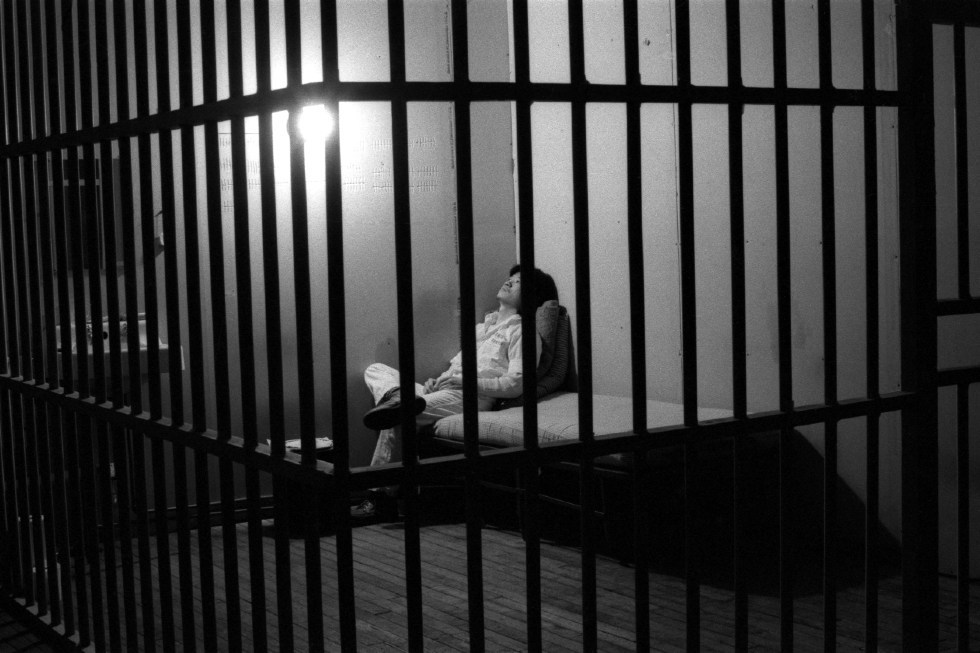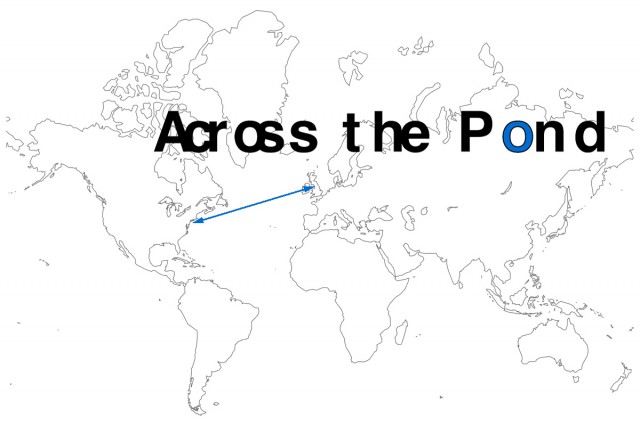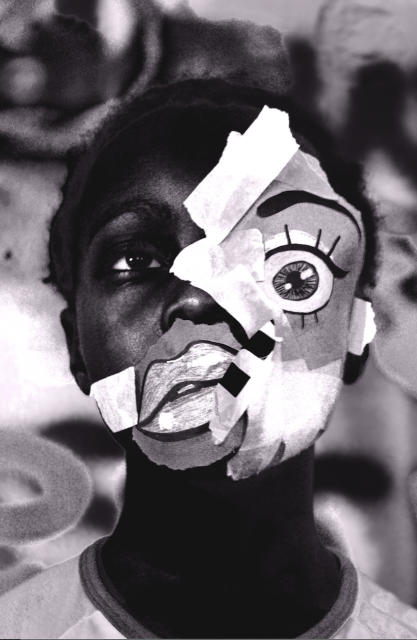Art, Life & Mental Health – In Conversation with Across the Pond

Our mental health is increasingly on the agenda, but the dialogue needs to continue should awareness, effective care – and destigmatisation – prevail. Mike Pinnington speaks to the co-founders of new international arts project, Across the Pond…
The Double Negative: What was the germ of the idea that led to the project?
Adam Zucker (NYC, US): For the past several months, Lizz and I have been chatting about art, life and dealing with mental health related issues. We haven’t had the chance to meet in person, which is ironic because shortly after we really started to click, the pandemic hit, and everyone was communicating and working remotely. So we had a leg-up, it seems. We have a great rapport and prompt each other to stay positive and push ourselves creatively. We started making daily drawings based on a set of themes we agreed upon, and launched an online exhibition space for addressing the need to keep presenting and making art in these dire times. I’m blessed to be able to have a friend who I can discuss mental health with, as well as the various aspects of being an artist. We have each been transforming aspects of our struggles with mental health into creative endeavors, so we thought it would be beneficial and timely to start a collective that combines our passions, personal identities, and desire to develop global opportunities that address mental health via the power of art.
Lizz Brady (MCR, UK): I was supposed to be flying out to New York on the 27th October! Which would have been the first time meeting Adam in person. I was successful with a grant from a-n, and it was to be a research trip, exploring mental health and art, in a different city and country. Like Adam says, I think the ideas for Across the Pond (AtP) just came naturally. It is an international branch of Broken Grey Wires (BGW). We both have mental health conditions and we talk about this a lot, the good and the bad. I guess I want to eradicate the stigma, and create a space to experience ‘madness’ within our communities.
Have you worked together before?
LB: We have, in fact, Adam selected my work in 2015 to be included in an exhibition in New York at Fountain House Gallery. This is how we originally ‘met’.
AZ: Yes, I was inspired by what Lizz was doing with Broken Grey Wires. I was inspired by the community she was building and the ways that art and artists were responding to mental health and other uniquely personal issues. It was an honor to display a sound artwork at Fountain House Gallery, which is a venue that supports artists dealing with a myriad of mental health-related experiences.
What gap will AtP fill?
AZ: There’s a great deal of stigma around mental health. The idea of the ‘tortured artist’ or ‘struggling artist’ is a connotation that we’d like to transcend. Yes, we all struggle, and a great deal of us experience mental duress, either consistently, seasonally or at some point in our lives. We want to welcome everyone who feels vulnerable and unheard to the table. With AtP, we are asking, rather, we are insisting on a safe space to experience mental illness. We are seeking to turn the dream of wanting better social, economic and healthcare services into tangible and holistic support networks for communities, and push the boundaries of art through encouragement, compassion and motivation. BGW has created a bridge for critically acclaimed artists and major institutions to open up a dialogue and provide inspiration and opportunities for people with mental health difficulties. We are branching out internationally and working with artists and mental health professionals throughout the six major continents (sorry Antarctica, maybe one day!).
LB: Yes! Adam puts that so well… There definitely feels like there is a gap here, but it isn’t about pushing people out the way, or being the ‘first’ to do this. We want to collaborate with people and organisations already laying the groundwork. It is important to work together to build something unique and powerful.

Present circumstances as they are, how will Across the Pond operate?
AZ: We are currently working remotely, which has basically accounted for a near 24/7 schedule. We have unique sleep cycles and are five hours apart, but nonetheless, it feels like we’re in constant communication. Our workflow will continue to be virtual since it is the easiest way to circumvent the cross continental divide. However, we’re in the midst of working on very exciting projects that will combine our two lovely continents. We will have both physical manifestations of our work in the form of exhibitions, installations, publications and workshops. Alternatively, as we’ve discovered during these unprecedented times, many of these things can also be supplemented online and through social media. We will combine both in-person and virtual operations in order to communicate with our intended international communities. Eventually, we’ll be able to safely travel again and we look forward to sitting down at the work table together with a hot cuppa.
LB: We set up Transmission Gallery at the beginning of lockdown (with Chris Bailkoski, director of PROFORMA) where we have two exhibitions live on the site. So we are quite apt at running things online. Of course, it’s not ideal; we want to socialise, we want to see art in person, we want physical connection, but everybody is adjusting to this new ‘world’ and as artists we have the opportunity to be at the forefront of these changes. Saying that though, I can not wait to be able to move around again, and hang out with Adam properly, whilst we devise our creative plans.
You have a number of artists attached to the project so far, tell us a little bit about how that came about, and why them.
AZ: The benefit of Lizz and I being situated in different geographical locations is that we each recommend local artists whom we have experience working with and also artists who we’ve wanted to work with. We also have a very similar ‘foundation’ of artists who we believe are core to our mission and philosophy. Joseph Beuys is one such artist. His work as an artist and educator demystified art by focusing on collaborative projects that utilised art for social change. His belief that everyone can be an artist is a mantra that I abide by. When we select artists to work with, it is a combination of whether they make work responding to our specific curatorial theme(s) and our collective admiration for the work they do.
LB: I have tried to follow the BGW pattern of selecting artists to work with; those whose work inspires me, those who are pushing boundaries in the art world and those who are ambitious and not afraid to speak out. Of course, the artists will also be exploring mental health in some ways; for our first project, artists [including Tehching Hsieh and Amber Akaunu] are responding to isolation through topics such as race, religion, suffering, social experiments, and even aliens!

How will Across the Pond manifest? Is the plan for it to be a long-term project?
LB: Our long term plan is incredibly ambitious, and we spend long nights discussing where we can take the project. Inspired by many organisations and work, like Bloom Building in Birkenhead, ABC No Rio (NYC) and Joseph Beuys’ Manifesto, we envisage AtP being a radical arts organisation, exploring mental health conditions through art. Having our own venue, gallery space with artist studios, zine library, a tools exchange point, workshop space, gig venue and bar. Of course, this all in the future, but I do believe it is good to have long term aims… And it is no longer a dream to want better mental health services, we shall now demand and build them together.
AZ: Through all of our manifestations, whether they be a permanent venue (which as Lizz beautifully described, would be a combination of a hostel, a workspace, a school and a social hangout), we are committed to forming sanctuary spaces for creative expression and empathy to be exhibited.
LB: In between our startup and art world transformation will be international exhibitions (thus far planned for New York and Manchester) with workshops, presentations and publications alongside. We are constantly researching and exploring; with two projects on the horizon. One responding to isolation, and the other project will be focusing on devising a safe space to experience mental illness, with Ernst May’s minimal dwelling, RD Laing’s Kingsley Hall and Foucault’s Panopticon theories all being examined.
As told to Mike Pinnington
Images, from top: Tehching Hsieh – Cage Piece 1978-1979; Amber Akuanu, Picture Perfect
You can support Across the Pond’s Crowdfunder until 22 November
Further Reading: Hi, How Are You? A conversation with Broken Grey Wires





